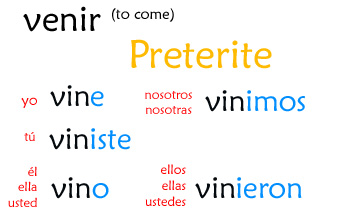This video lesson covers venir (to come). Venir is of course another irregular verb in the preterite. In this video, I also mention that whenever a verb has any irregular inside of it due to a prefix, the verb follow the pattern of the irregular.
Ex: suponer, mantener, detener, prevenir, etc
Enjoy!
Leave any questions, comments or suggestions below.
conjugation chart:

Vocabulario:
mi(s) – my
los amigos – friends
su(s) – his, her, your, their
la novia – girlfriend
la fiesta – party
nadie – no one
la clase – class
de – of, from, about
biología – biology
ayer – yesterday
a – to
el baile – dance
con – with
la casa – house
—————————————–
Related video(s):
“Nadie” is a singular word so takes the singular form of the verb. Vino.
El ejemplo…no one came to biology class. Why was.. nadie vino a la clase de biologia, instead of…nadie vinieron a la clase de biologia?
Isn´t nobody came to the class, the same as they all didn´t come to the class?
Gracias por su ayudar
Nadie vino a la classe de biologio. Why is there “a la” in the sentence? Im guessing it would be similiar to… “to go” example…. Ellos van a la tienda….
Randy,
‘a’ is often used in reference to motion… as in… to go to or to come to a place. In this case, “no one came TO the biology class” that’s why the “a” is needed.
-Sr. J
The only thing tjat confuses me are he,se,te,ti&si could u make a video about how u use them that would be cool